The few links I added to the original article point at relevant pages of my site, and these linked pages are not part of the original publication.
I, along with several ufologists and scientists, also do not share all the ideas presented in the article (the Washington sightings of 1952 are not explainable in terms of "temperature inversion.") Neverthless, this mainstream magazine article is a document of interest in UFO litterature.
![]() Part I
Part I
![]() Part II
Part II
![]() Part III (This page)
Part III (This page)
October 8, 1978
In the late 1970s, the long-friendly relationship between the United States and Iran soured after the ouster of the Shah of Iran. Anticipating armed conflict, both sides ratcheted up their military preparedness. With U.S. spy satellites looking down and Iranian radar installations looking up, the skies over Iran became the most heavily monitored airspace in the world.
Had it not been for these political events, it is doubtful the U.S. Joint Chiefs of Staff would have been interested in a snapshot taken by 16-year-old Jamshid Saiadipour. Up late studying for exams in June 1978, he saw and photographed a UFO from the window of his family's apartment in the town of Sheraz.
The photo caused a stir among ufologists because it resembled a UFO reported by pilots during their landing approach to the Teheran airport earlier in the year.
On Oct. 8, 1978, a similar craft was photographed by another youngster, Franklin Youri, from outside his home near Lake Urmia in western Iran. This picture, however, was not revealed until the Youri family relocated to the United States three years later.
A Freedom of Information Act request and lawsuit (see "What The Government Really Knows About UFO Sightings" below) ultimately led to the release of Defense Department documents that revealed the American military's interest in the sightings.
What made ufologists and the U.S. military so interested in photos of UFOs taken by two Iranian teenagers? Ufologists claim that Iranian airspace had been a hotbed of UFO activity for many years. They say a pivotal moment occurred on Sept. 19, 1978, with an encounter between two Iranian Phantom jets and an object that failed to appear on radar. When the American-made F-4 fighters got close enough to release their air-to-air missiles, the planes' weapons-firing control systems mysteriously and repeatedly failed.
Skeptics point out the real reason for the interest from the Joint Chiefs of Staff may have been the strong resemblance between the object that appeared in the two photos and a then-secret stealth aircraft, Tacit Blue. Based at the former Area 51 secret aircraft development center in Nevada, it was designed to test stealth technology.
Ufologists say the case needs further investigation. Until then it remains a valid UFO.
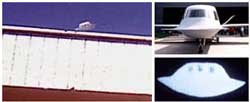
The Sheraz photo, shown enlarged in the lower right corner, closely resembles Tacit Blue, a secret stealth jet.
January 16, 1958
When ufologists and skeptics can't find strings, shadows or signs that a UFO photo is faked, they question the credibility of the photographer and witnesses. Trained observers–including pilots, ship captains and military officers–are usually considered the best witnesses. It is the credibility of the 47 crew members of the Brazilian naval vessel Almirante Saldanha that makes the Trindade, Brazil UFO photos so important.
As part of its contribution to the 1957-58 International Geophysical Year, the Brazilian navy set up a weather station on the small rocky island of Trindade, in the south Atlantic Ocean. In January 1958, observers began spotting unusual aerial activity, including fast-flying disks. On the night of Jan. 16, the disk shown here appeared within view of the ship's company.
Among those present was civilian photographer Almiro Barauna, who snapped a series of six photos. After the ship returned to port, the photos, which had been developed on board in a makeshift darkroom, were turned over to the Brazilian Navy Ministry. Analysts determined the photos to be authentic and concluded they showed a 50-ft.-dia. object moving at 600 mph.
Skeptics have offered two explanations for the craft. Initially, Harvard University astronomy professor Donald H. Menzel said the UFO was simply a plane flying through fog. Then, in the first of several books he would write debunking UFOs, he claimed the photos were faked. Barauna, he said, had first photographed a model UFO in his home and later double-exposed the same roll of film with pictures of the open sky. However, a 1978 examination by an independent laboratory using digital photo analysis ruled out such tampering.
"Given the number of witnesses, the results of photo analysis, both military and civilian, and the need for debunkers to reinvent the incident to 'explain' it, it seems most unlikely that the Trindade photographs were hoaxed," says JAHCUS's Clark.
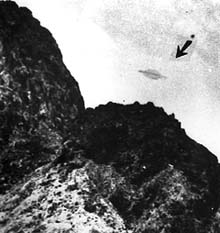
The Trindade UFO was photographed and seen by more qualified observers than any other sighting.
December 27, 1980
"I started my tour of duty believing in aircraft lights," Nick Pope tells me as we eat a traditional English lunch of fish and chips at London's Red Lion pub, just down the block from his office in the British Ministry of Defence (MOD). "I ended it believing in aliens."
For three years Pope was assigned to the MOD office responsible for investigating UFO reports. Holding a rank equivalent to captain, he knew the detours around the roadblocks bureaucrats put in the way of ufologists.
Among the cases he examined was an incident that has come to be known as England's Roswell. It occurred over the last days of December 1980, near a now-closed U.S. Air Force base in Bentwaters. For two nights security patrols observed unusual lights in the Rendlesham Forest just beyond the base's fence. On the second night they entered the forest with generator-powered floodlights, Geiger counters and 2-way radios. At the critical moment when an angular, 20-ft.-wide, 30-ft.-tall craft appeared, the radiation-detecting instruments started to clatter and the spotlights and radios began to sporadically fail.
Daylight revealed broken tree limbs and three 1 1/2-in. deep, 7-in.-dia. circular depressions, suggesting something had landed, just as the observers claimed.
Initially, skeptics dismissed this physical evidence as wind damage. They explained the unusual lights by constructing a complex chain of events that included unusual astronomical activity, satellite debris burning up on reentry, and the rotating beam of a lighthouse several miles away.
What the skeptics couldn't explain, says Pope, is a scientific report he found in the MOD files. It revealed radiation levels 25 times higher than normal background levels in the soil and trees surrounding the landing site.
England's UFO investigator, Nick Pope, went from skeptic to believer.
As Pope delved more deeply into MOD files he found that the Bentwaters case, as it is known to ufologists in the United States, was the second to occur in the Rendlesham Forest.
On August 13, 1956, British radar had picked up blips similar to a jet aircraft's–only it was moving at speeds up to 9000 mph. Technicians later told investigators for Project Blue Book that diagnostics checks indicated their radar was operating normally. The incident remained classified until 1969.
Pope said the two Bentwaters episodes and others he investigated during his stint as England's top UFO investigator moved him from skeptic to believer, and inspired him to write a book titled Open Skies, Closed Minds.
"As long as we are all afraid of ridicule, the UFOs are going to be ignored," says Pope. "Perhaps we ignore them at our peril."
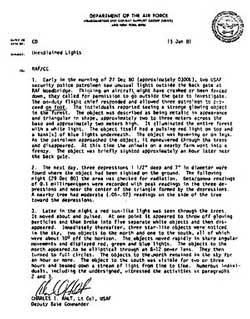
The USAF account was found in British UFO files.
November 13, 1966
For those who believe UFOs are piloted by child-size creatures with large almond eyes, any sighting that takes place in the state of Ohio merits special attention.
The attraction is Wright-Patterson Air Force Base. In addition to being the headquarters for Project Blue Book, it was also home to the Air Technical Intelligence Centers, which analyzed flying machines based on Nazi German "flying disc" designs (see Roswell Plus 50, July '97). What makes these stories even more appealing are recurring rumors that the base is also the repository for debris from crashed UFOs, and alien bodies.
Ohio holds another distinction in UFO lore. In Zanesville, on Nov. 13, 1966, local barber and amateur astronomer Ralph Ditter took the two spectacular UFO photos shown here. Beyond their detail–which to some skeptics is evidence itself of fraud–the importance of the photos lies in their similarity to the craft reported during a series of sightings that occurred throughout the year.
At least two of these sightings were made by law enforcement officials, credible witnesses on everyone's list. In Toledo, on March 25, two Lucas County deputies, Robert Schultz and Stanley Nelepa, reported seeing a huge object floating at treetop level. Four days later, a glowing orange object was seen floating over the Ohio Turnpike administration building in Berea. Three days later it was spotted a second time, by Berea patrolmen Clarence T. Janowick and John R. Galik Jr.
Because Ditter took his photos with a Polaroid camera, there are no negatives to investigate for signs of tampering. The jury remains out–and perhaps may never be able to return a verdict on whether the Zanesville photos are spectacular evidence or spectacular frauds.
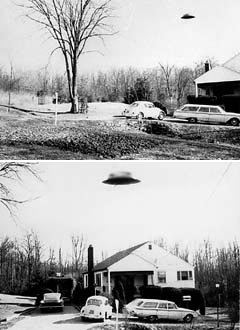
The Zanesville photos fit descriptions of craft seen by police and sheriff's deputies elsewhere in Ohio in the spring and fall of 1966.
March 21, 1966
Ufologists sometimes say skeptics are people who haven't had a "close encounter." Josef Allen Hynek, who coined the phrase "close encounter," might agree.
Hynek was a University of Chicago-trained astrophysicist and confirmed skeptic who served as the scientific consultant to the Air Force Project Blue Book UFO investigation. And then he changed sides. The case that prompted his conversion occurred in Hillsdale County, Mich., on March 21, 1966, and involves the photo shown here.
At about 10:30 pm a resident of the women's dormitory at Hillsdale College reported a strange object in the sky. County Civil Defense director William E. Van Horn responded and confirmed that a bright glowing object was indeed bouncing across a nearby hollow and then became airborne. Hynek, who died in 1986, dismissed the Hillsdale sighting as "swamp gas." Within two weeks, however, he changed not only his opinion about the sighting, but also sides in the great UFO debate.
Perhaps it was the contents of Van Horn's report that sparked the conversion. Soil analysis showed that on the very spot where the "swamp gas" had touched down, radiation levels were higher than in the surrounding terrain. More significant still was the finding that the ground was also contaminated with boron, the element used to slow nuclear chain reactions.
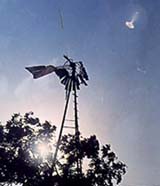
As with the Bentwaters site, higher radiation levels were also found at the Hillsdale site.